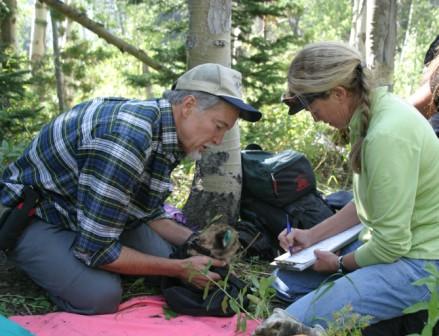An interview with cougar expert, Howard Quigley
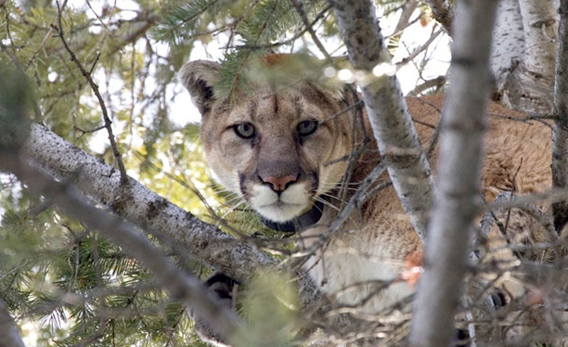
California cougar. Photo by Travis Bartnick
It holds the Guinness World Record for having the most names of any animal on the planet, with 40 in English alone. It’s also the widest-ranging native land animal in the Americas, yet is declining throughout much of its range. Mongabay talks with big cat expert Dr. Howard Quigley about the status and research implications of the elusive, enigmatic, and unique cougar.
It is thought that the forebear of the cougar migrated from Asia into North America over the Bering land bridge approximately 8 million years ago, where it evolved into the different cat lineages present today. Cougars subsequently invaded South America three million years ago when the isthmus of Panama formed to connect the two continents. Genetic studies have shown that today’s North American populations are all very similar, suggesting a population bottleneck contemporaneous with the megafauna extinction of approximately 10,000 years ago during which large North American mammals such as Smilodon went extinct. Researchers believe that during this time cougars were largely or entirely extirpated from the whole of the continent, with today’s populations refounded by cougars from South American.
Although it can weigh up to 220 pounds, making it the second largest felid in the Americas (after the jaguar), the cougar is actually more related to smaller cat species such as ocelots and lynx than it is to lions and tigers. Originally, it was even grouped in the same genus as the domestic cat (Felis), but in 1993 was given its own genus, Puma, which it shares with its closest living relative, the jaguarundi.
Interestingly, even though they are in separate subfamilies, cougars and leopards are capable of hybridizing. In the 1890s and early 1900s, an animal park in Germany bred a female cougar with a male leopard while a Berlin zoo bred a male puma to a female leopard. The resulting “pumapards” had the long body of a cougar with the rosettes of a leopard on a tawny or grey coat. Most died while young, and those that did reach adulthood grew to be only half the size of their parents due to genetic dwarfism.
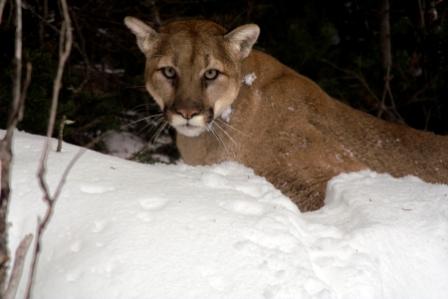 An adult cougar – photo by Larry Westbrook |
With habitat extending from the Yukon to the Andes, the cougar is the widest ranging land animal in the Americas due to their ability to live in virtually any environment. However, even with their vast range, there are estimated to be only 50,000 wild cougars in the world.
In South and Central America, laws enacted in 1996 outlawed the hunting of cougars in Argentina, Brazil, Bolivia, Chile, Colombia, Costa Rica, French Guiana, Guatemala, Honduras, Nicaragua, Panama, Paraguay, Suriname, Venezuela, and Uruguay. Cougars have no protection measures in place in Ecuador, El Salvador, and Guyana.
In North America, cougars became extirpated from most of the Eastern U.S. and Canada after European colonization. The only resident eastern population is the critically endangered Florida panther which occupies only five percent of its historic range and numbers just 50-100 individuals. Many states and provinces in the western portions of the U.S. and Canada have resident cougar populations, and all except California and the Yukon allow hunting. However, most have enacted certain protection measures. The lone exception is Texas, where hunting of the cats in largely unregulated. The state groups cougars with ticks and pigeons as “nuisance wildlife”, and allows anyone with a hunting or trapping permit to kill a cougar regardless of sex, size, or age.
Cougars are threatened by habitat loss and by direct persecution by humans. The latter is primarily caused by the perceived threat of cougars on livestock, although the risk of attacks on humans is sometimes used to justify the killing of a cougar near urban areas.
In reality, cougars have a minuscule effect on livestock numbers. In Texas in 1990, for example, cougar kills amounted to 445 sheep (0.02 percent of a total of the state’s total of 2.0 million sheep and lambs) and 86 calves (0.0006 percent of the state’s total of 13.4 million cattle and calves).
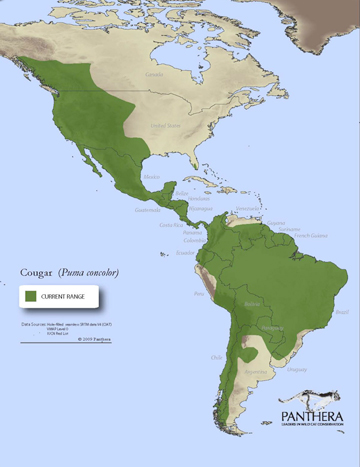 Cougar range map. Image courtesy of Panthera |
Attacks on people are incredibly rare, but are increasing due to expansion of human populations into cougar habitat. In the hundred years spanning 1890 to 1990, there were only 53 confirmed attacks by cougars on humans, resulting in ten deaths. From 1990 to 2004, the number of attacks had climbed to 88 with a total of 20 deaths. Even though the frequency of attacks on humans is relatively small, those which do happen are heavily covered by the media, effectively maligning cougars in the public eye and drawing attention away from the critical roles they play in many ecosystems.
However, the main reason behind cougar decline in the U.S. is habitat loss through degradation and fragmentation. Research shows that cougars need at least 850 square miles of uninterrupted habitat in order to persist with only a low risk of extinction. With urban areas becoming more numerous, many scientists are calling for the expansion of protected habitat corridors so that cougar populations could exist and move without needing to traverse through civilization.
One of the major players in cougar conservation is Panthera, an organization whose mission is to ensure the future of wild cats through scientific leadership and global conservation action. Panthera is the world’s largest dedicated funder of wild cat conservation, and in addition to cougars includes tigers, lions, cheetahs, leopards, snow leopards, and jaguars as its focal species. Panthera has sponsored many innovative conservation measures such as the Jaguar Corridor, a program that is working to connect jaguar habitats from the top of their range at the Mexican-American border all the way down to the end of their range in Northern Argentina, and the Snow Leopard Initiative which was launched in Beijing in 2008.
Panthera is currently conducting two projects which focus on cougar conservation: the California Cougar Project and the Teton Cougar Project. The Teton Cougar Project, a joint Panthera-Craighead Beringia South initiative in its ninth year, is working to gather data about the cougar population of Jackson Hole, Wyoming, and the southern Greater Yellowstone Ecosystem with the aim of increasing knowledge of cougar population dynamics and interactions with competing carnivores and humans.
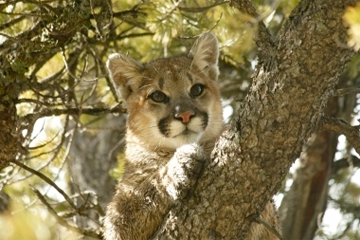 Cougar. Photo by Travis Bartnick |
The California Cougar Project aims to reverse the trend of habitat fragmentation and increase habitat resiliency by evaluating the existence and potential of corridors to link cougar populations within the state’s 99 million acres of optimal cougar habitat. The project also includes an outreach component to communicate the benefits of cougar conservation while educating communities about how to successfully live with the big cats.
Both Teton and California Cougar Projects are led by cougar expert and the Executive Director of Panthera’s Jaguar Program, Dr. Howard Quigley. Dr. Quigley conducted field studies of giant pandas in China, Siberian tigers in the Russian Far East, cougars in central Idaho, and jaguars in the Brazilian Pantanal, before joining Panthera in 2009. He is a member of the IUCN Cat Specialist Group and is called on for his expert advice on many issues including jaguar recovery in the U.S., cougar-human interactions, and jaguar-rancher conflicts in Latin America. Dr. Quigley has also written more than thirty scientific publications and popular articles.
In January of 2011, Dr. Quigley discussed the state of cougar conservation in the U.S. with mongabay.com.
What motivated your personal interest in big cats?
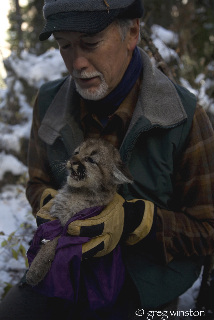 Dr. Quigley with a cougar cub – photo by Greg Winston |
Howard Quigley: When I was younger, we did a lot of camping and fishing outdoors. I enjoyed it and I would have to say that early on I started looking for some challenges. That is, I was going to go to college and was looking for the biggest challenges in the world and although I was interested in wildlife and the outdoors, I never saw it as a career. In fact, what I chose was Psychology and Sociology, figuring that those were the biggest challenges; like understanding the human mind, solving the problems of the human race, and those sorts of things.
As I got further along, I realized that being a Psychologist or Sociologist was helping a few people a little bit along the way and I at some point became interested in seeking a career outdoors. And I had watched wildlife quite a bit and their behaviors, (such as) how they reacted to people, and I saw that maybe one of the biggest challenges was trying to understand ecology; how organisms fit together and that might be just as challenging and just as complicated as the human mind. Maybe even more so. And, lastly, it was the need. That wildlife was pure and complicated, but it was challenged by humans. So I thought that being able to perhaps contribute to their survival could be a rewarding career.
How do cougars contribute to their environment?
Howard Quigley: Like every species, they act as a piece of the puzzle, a piece of the ecological organization, a cog in the ecological moving wheels. Every species is important, but cougars, like other predators, have perhaps additional roles in organizing natural communities. Through predation they influence the behavior, they even influence the physiology of different animals because of the role that predation plays in these systems. Thus, probably deer and elk are more vigilant, deer and elk are more astute. Why do deer have such great hearing? Why do elk have such great visual acuity? Why are their senses so keen? Well, predation and predators is a very big part of that. Thus, cougars also play a role in the direction of evolution. That is, the animals that escape predation are likely to be more fit, as we say in ecology.
Cougars play a role in improving the stock of prey that exist on the land. They even influence the distribution of animals within a system. Thus, they play a very important role and their loss brings down a sort of house of cards in an ecological collapse as has been coined in the past. Maintaining cougars isn’t easy, but the role that they play in ecosystem dynamics cannot be understated.
Why do you think cougars have gotten such a bad reputation? What can be done about it?
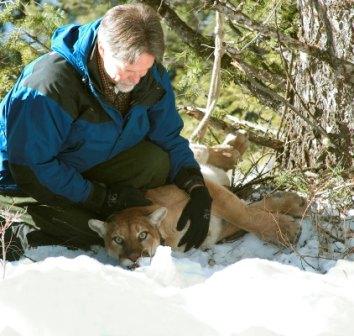 Dr. Quigley works on a captured adult cougar – photo by Steve Winter/Panthera |
Howard Quigley: This is a great question and it deserves potentially a whole day to discuss. But, in the short answer form, its people and the media. For most carnivores, I just encourage people to learn more; that always helps. With carnivores, you hear the “bad things” mostly, like how “they kill things”, and adjectives like, “vicious” are always associated with carnivores. You don’t get the whole story. That’s why I encourage people to scratch deeper, find out more than just the article in the paper. And, with cougars, it’s accentuated because you don’t see them. Their secretive nature works against them; people become suspicious of things they know are there, but they can’t see. You can see deer; you can see eagles, but you can’t just sit and watch a cougar in the wild. Then, you hear some news story about a cougar sighting, or a cougar that killed a dog, or a cougar that wandered into town and had to be shot. All of this creates an image, an image that works against measured and progressive conservation approaches.
What can be done? On the individual front, people need to, like I said, scratch the surface and be more probing about cougars. From the professional standpoint, we have to be aggressive about getting the message out to the general public.
Why are California and Florida the only states which have outlawed the hunting of cougars?
Howard Quigley: The answer to this one is really two different answers for two different places. The Florida panther is the same species as the California cougars or mountain lions; it’s just a subspecies. The hunting of Florida panthers is outlawed basically because there are so few. It’s one of the original members of the Endangered Species list back in the 1970s, and their protection has been critical. Hunting that population would not be biologically justifiable let alone socially justifiable.
In California, it’s really a cultural issue. The banning of hunting in California has a long history behind it. Ultimately, the people of California voted a ban on the hunting of cougars many years ago. The people of California decided that they didn’t want hunting of cougars and they also wanted cougar habitat protected, and they said that in a ballot initiative.
Do you think other states will follow suit?
Howard Quigley: No, I don’t think so. I don’t see a political or social situation in another state such as California had when the ban was enacted. I could be wrong; there are states that could take on the issue of hunting bans for cougars. But I don’t see any states right now that might do that. If anything, the expansion of cougars into the Midwest could increase the number of states that have cougars and that do hunt cougars, whether that’s justified (depends on) how those populations develop. Socially, those states are strong hunting states so I suspect that hunting of cougars in those states would be supported.
|
|
There have been recent reports of cougars in the eastern United States. Do you think that it’s possible for cougars to reestablish themselves in that part of the country?
Yes, it’s possible for cougars to re-populate the eastern United States; in fact, it’s going to happen at some point. Cougars have a very impressive capability for dispersal and colonization. But it’s all about us “making way” for it. The best thing would be that we maintain natural areas and deer populations. It might not be next year, but 50 years from now I suspect there will be pockets of cougar populations. But “making way” is not just maintaining natural areas, it’s preparing people and getting the word out about cougars and the beneficial ecological roles that they and other carnivores play. It does and it will have its downside – wildlife agencies will have to deal with a few cougars that get in trouble, for instance – but overall, we need to prepare for the day when cougars once again give birth to little cougars in the Adirondacks or the Smokies.
What do you think is needed for humans and cougars to successfully coexist?
Howard Quigley: The simple answer is knowledge and understanding. Lack of knowledge, as its been said over and over, breeds contempt, especially when a lot of the information that is dispersed tends to be negative. The more you know about big cats, the more you know about mountain lions, the more you appreciate their existence and our continued need for their existence.
What motivated Panthera’s interest in cougar conservation?
Howard Quigley: Cougar conservation is a small but growing part of Panthera’s portfolio of cat conservation. With the pressing issues of the conservation of tigers, African lions, and snow leopards, it’s hard for Panthera to (focus on cougars). It’s difficult for Panthera to work on the other 34 species, or to justify working on the other 34 species of wild cats in the world. But we do. When we see particular motivation scientifically or ethically we do jump on those opportunities. In fact, we fund a Small Cat Research Fund through the IUCN.
But the motivation for Panthera to work on cougars in North America is probably two-fold. One is that there is probably more science and scientists working directly on cougars than any other large cat in the world. Thus, if we can pool what they are doing with cougars we can apply that to other large cats and other large carnivores around the world. It’s a huge opportunity to delve into the science of cougar conservation and management in North America and be able to perform outreach with and hygrate that to help other large cats. Secondly, our founder, Tom Kaplan initiated discussion within Panthera with the question: how can we work on cats around the world and not be involved in cougar conservation in North America? And, that brought up (the question): where can we focus? This is a species that occurs all over the western U.S. and into central Canada. What could we possibly do to be able to contribute to cougar conservation?
What was the impetus behind the California Cougar Project and Teton Cougar Project?
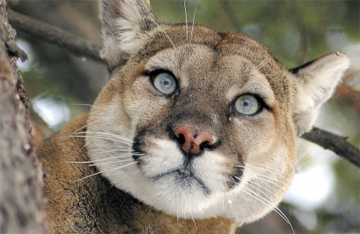 Cougar. Photo by Brad Boner |
Howard Quigley: The Teton Cougar Project is a long-term project that has just a few more years to go. The impetus behind it was that we have the Endangered Species Act providing an experimental environment for understanding North American systems. This is immense! Wolves have been reintroduced, and grizzly bears have been nurtured back to health. During this time, cougars have taken advantage of some very interesting ecological opportunities. Now, all of the big predators are back. We chose cougars because they were the most mysterious and the most unknown and we are going to find a way to understand the system as it was 100 or 200 years ago when explorers first came into the Rockies, as well as even prior to that, when Indians occupied these systems along with these big carnivores.
The California Cougar Project, on the other hand, is an attempt to understand how one of the most resilient big carnivores on the plant, the cougar, can adapt to the presence of people. If we can understand that, how they survive, how they breed, how they avoid people, we can begin to understand how we can live with the whole system of predators and people on the planet.
How will your conservation endeavors be applied to large cat conservation worldwide?
Howard Quigley: The cougar programs are becoming a paradigm. The objective here is to be able to bring cougar science to the rest of the world. It’s not that there aren’t good scientists doing great work on the rest of the big cats of the world – tigers, African lions, jaguars – but the issue is bringing the science to cats. I think science tends to be parochial, tends to be local, tends to be regional, and we need to make it world-wide and in the realm of felid ecology. We have such a resource in North America that needs to be outreached to the rest of the word. And, I don’t mean this in an imperialist way, I mean it in a comprehensive and inclusive way, in a way that I think many scientists find very difficult. It’s outreach, outreach, outreach. It’s not “defend your territory”, it’s “go and expose your abilities to the rest of the world”. And although it’s difficult, I think that what we are doing with cougars in North America needs to be outreached to the rest of the world.
The amount of science that’s being done on cougars is just tremendous, and if we can immerse that science and those individuals into cat conservation world-wide, we could really develop the kind of safety net that large cats need right now. In fact, they needed it yesterday and we’re running against the clock.
What have your projects revealed so far? What do you hope is accomplished through them in the future?
Howard Quigley: The Teton Cougar Project is just beginning to wrap up and we are just beginning to see all of the highlights and exposure we’ve been able to bring about on cougar ecology. We found out that there’s been a whole lot more interaction between adult cougars than ever thought before. They are called the “solitary carnivores” but, in reality, they have a whole bunch of different ways that they communicate with each other – by marking their territories, by coming to visit. We’ve even found situations where males come back to visit females with which they have mated and the females have kittens. It’s almost like an expanded African lion’s society where males know where all the females are, they go visit them, and they defend their territory. It’s truly an amazing system.
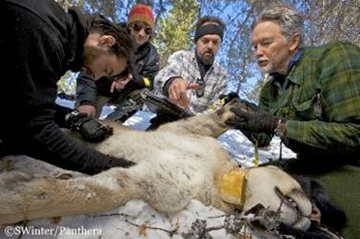 In February 2010, Panthera’s Vice President, Dr. Luke Hunter, and Jaguar Program Director, Dr. Howard Quigley, led a team of scientists through the snowy hills of Wyoming to re-collar a young male cougar that Quigley has been monitoring for the past four years. The team took hair samples from the cougar to learn more about his diet, and measured and weighed the cougar to assess his overall health. After a comprehensive check-up, the team replaced the cougar’s collar and released him back into the wild, where his movements will be closely tracked to help determine his movement, ecological requirements, and population dynamics, until his next check-up. Photo by Steve Winter/Panthera. |
Through the California Cougar Project we have laid out the basic framework for the Project by interviewing and connecting with experts in California. Our bottom line is that there are two things needed. The first is increased dispersal of information about mountain lions to the public; the second is (the realization) that cougars could be used very nicely in the state of California to develop an integrated approach to conservation via corridors and protected areas. There’s just no better model than the movement of cougars across that landscape in order to develop these corridors and this kind of integrated long-term conservation. So, our next approach is to try to coalesce a lot of the data that is currently being collected, as well as collecting additional data to be able to model, prove, and then put in place measures for long-term conservation of the corridors.
Do you have any advice for people who are wanting to help with cougar conservation?
Howard Quigley: For those that want to help cougar conservation, it’s a simple game: information, time, and money. That’s usually what citizens can give with just about any conservation cause. Seek information and disperse information, solid information. It’s surprising how little information there is about cougars. The state of CA has more cougars than any other state, but the most common pieces of information you get there about cougars are the newspaper articles about the ‘bad cougar” that was seen on the edge of town.
Seek information, and even help with information outreach such as asking the local newspaper columnist questions about cougars, or writing a column about them. Or volunteer a column to your local paper, and educate yourself and others. Give a presentation to local groups, or volunteer for a cougar monitoring program in your area. Use your time to become a good observer of cougar signs if you have cougars in your area; look for tracks, then teach a friend. It can be very rewarding.
And, of course, money. Find an organization which you think is doing some good with cougars, and give. There’s never enough money for cougar science and conservation, and even the state agencies responsible for cougars don’t have good sources of funds for them. For instance, the cougar programs at Panthera are run primarily on outside funding that I seek.
If you’d like to get involved right now, we are vying for a $25,000 Pepsi Refresh Grant for our cougar project in Wyoming: “Studying cougars in the Yellowstone ecosystem using camera traps”. You could go to the following link and cast your vote for our project…we need the votes.
http://www.refresheverything.com/panthera
The hair-snare: non-invasive animal research technique makes good in Mexico
(12/19/2010) It’s not easy or cheap to catch an elusive wild cat, and trapping such an animal can prove harmful to the individual. With such factors in mind, researchers are consistently turning to non-invasive methods of gathering data about species, including collecting feces and the increasingly popular camera trap. But one method rarely gets mentioned: the humble hair-snare. A new study in mongabay.com’s open access journal Tropical Conservation Science has demonstrated the success of hair-snare in gathering data about mammals in Mexico, including the first successful hair catch of two rarely seen cat species, the jaguarundi (Puma yagouaroundi) and the margay (Leopardus wiedii).
Could camera traps save wildlife worldwide?

(08/31/2010) It’s safe to say that the humble camera trap has revolutionized wildlife conservation. This simple contraption—an automated digital camera that takes a flash photo whenever an animal triggers an infrared sensor—has allowed scientists to collect photographic evidence of rarely seen, and often globally endangered species, with little expense and relative ease—at least compared to tromping through tropical forests and swamps looking for endangered rhino scat . Now researchers with the Wildlife Conservation Society (WCS) and the Zoological Society of London (ZSL) are taking the utility of the camera trap one step further: a study in Animal Conservation uses a novel methodology, entitled the Wildlife Picture Index (WPI), to analyze population trends of 26 species in Bukit Barisan Selatan National Park on the Indonesian island of Sumatra. While the study found a bleak decline in species, it shows the potential of camera traps for moving conservation forward since it marks the first time researchers have used camera traps to analyze long-term population trends of multiple species.
Dangerous and exploitative: a look at pet wild cats
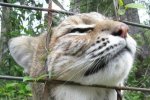
(07/13/2010) From bobcats, lynx, and pumas to the thousands of lions, tigers, leopards, cheetahs, and little wildcats living in captive environments, the WildCat Conservation Legal Aid Society is solely devoted to ending the commercial exploitation of all wildcats. Its primary objectives are to drastically reduce and subsequently eliminate the private ownership of wildcats as pets; wildcats held in roadside zoos and pseudo-sanctuaries; using wildcats for entertainment purposes; as well as hunting, trafficking, and trade of wildcats. Lisa Tekancic is an attorney in Washington, DC and founder and president of WildCat Conservation Legal Aid Society. Their mission is to protect and defend all native and non-native wildcats. Lisa is an active member of the DC Bar’s Animal Law Committee and has organized and moderated two legal conferences: ‘Trafficking, Trade, and Transport of Wildlife,’ and ‘Wildlife and the Law.’ She presented a paper on the methodology of ‘Animal Ethics Committee’ for the International Conference on Environmental Enrichment, and for four years was volunteer staff at the National Zoological Park’s, Cheetah Station.
